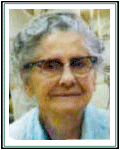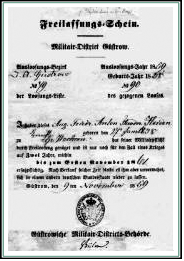|
 In 1972, for some long forgotten reason, I
(Ralph Heiden) became interested in the
history of the Heiden family. I began to wonder where we came from
and how our family came to Monroe County, Michigan of all places. At
that time, the oldest living relative that I knew was my father,
Arthur Heiden's,
Aunt Agnes (Brockman) Heiden who lived on South Custer Road. She was the wife
of my grandfather,
William Carl Heiden's, brother,
John. All of that generation of Heidens
were gone then except for Aunt Agnes who was 81 years old at the
time. One Saturday morning, my mother,
Mildred (Roggerman) Heiden, and I went to pay her a visit. In 1972, for some long forgotten reason, I
(Ralph Heiden) became interested in the
history of the Heiden family. I began to wonder where we came from
and how our family came to Monroe County, Michigan of all places. At
that time, the oldest living relative that I knew was my father,
Arthur Heiden's,
Aunt Agnes (Brockman) Heiden who lived on South Custer Road. She was the wife
of my grandfather,
William Carl Heiden's, brother,
John. All of that generation of Heidens
were gone then except for Aunt Agnes who was 81 years old at the
time. One Saturday morning, my mother,
Mildred (Roggerman) Heiden, and I went to pay her a visit.
As we talked and I asked questions about the older generations of
Heidens, it became clear that she had many fond memories of the
family but, as is the case with most of us, her memory of the
specifics of dates and facts was a bit fuzzy. I asked if she might
have any old papers that could help us. She thought for a moment and
said, “Well, I think there is an old box or two up in the attic. I
haven’t looked at them in years.”
She went up to the attic and soon returned with an old reddish brown
wooden box with a hinged top and two latches on the side. It was
about a foot high and six inches wide. We slid the latches aside and
opened the box to discover a treasure of documents, papers and
receipts that would help tremendously in the search for the German
roots of the Heiden family.
In the box were many old, yellowing papers covered by nearly
illegible scratches in German script written with a fine point ink
pen. There were also official looking documents machine printed in
both German and English. Included were many hand written notes and
receipts for long forgotten transactions.
When Agnes saw my excitement at the discovery, she said, “ You know,
I think I have some
old letters around here too. You might as well
have them if you are interested in all this stuff.”
With that, she went into another room and, in a few minutes,
returned with a small cardboard box about 8 by 10 inches and an inch
deep. It was a sturdy box but looked well worn with age. I opened it
and discovered several envelopes addressed in that same old German
script lettering. One was addressed, “Mastr Heinrich un Ernst Heiden
in Monerow, bei Chicago, Staaten Michigan, Nord-Amerika.” Many
others had been sent to “Frau Ww. August Heiden, Monroe-Mich, Nord-Amerika.”
From the envelopes, it appeared that most had been sent by
someone named
Marie Dohmstrich while others were also signed by an Emilie Dahme. They
were mailed from
Rostock, Germany over a period of several years in
the 1920's. Inside the envelopes were letters also written in a
flowing script handwriting that was totally unintelligible to me. I
had no idea who these people were or why they were writing to my
great-grandparents but I knew I wanted to find out.
In the bigger box there were many documents that provided much
needed information. Included were three very old looking pages, each
of which had a red wax seal affixed near the bottom next to a
signature. They were each dated April 22, 1873 and were signed by an
official in the German town of
Klaber. From what I could make out,
these were documents from the home province of my great grandfather,
August Heiden, that may have have had something to do with
proof of
citizenship.
 One page was for August Friederich Anton Theodor Heiden son of Maria
Heiden from the village of Gr. Wokern. He was born January 27, 1838
and baptized on February 4th of that year. The second document
concerned Elisabeth Sophie Wilhelmine Friederike Adolphine Knaak,
August’s wife who was born November 3, 1841 and baptized November
14th. The last page dealt with Meta Friederike Henrietta Elisabeth
Heiden, their daughter, who was born on December 23, 1870 and
baptized January 8, 1871. Two sons, Heinrich and Ernst also came
with their parents from Germany but their documents were not in the
box. One page was for August Friederich Anton Theodor Heiden son of Maria
Heiden from the village of Gr. Wokern. He was born January 27, 1838
and baptized on February 4th of that year. The second document
concerned Elisabeth Sophie Wilhelmine Friederike Adolphine Knaak,
August’s wife who was born November 3, 1841 and baptized November
14th. The last page dealt with Meta Friederike Henrietta Elisabeth
Heiden, their daughter, who was born on December 23, 1870 and
baptized January 8, 1871. Two sons, Heinrich and Ernst also came
with their parents from Germany but their documents were not in the
box.
These papers presented a bit of a mystery. I knew my grandfather,
William Carl Heiden, had two brothers,
Heinrich and
Ernest
(Ernst), but who was
Meta? To my knowledge, there
had been no mention of
an adult woman named Meta in the family. There was an old story,
however, about a child who had died at sea on the voyage from
Germany. Was that story true? Could this be her? Little did I know
that it would be over 20 years before I would finally learn the fate
of Meta Heiden.
These documents were where I began to see the
names of
Gross Wokern,
Klaber, Güstrow,
Mamerow, Neinhagen,
Ribnitz-Damgarten and
Teterow, the small German villages and towns
were our ancestors lived. Discovering these names was extremely
valuable for conducting further research into the German Heidens
during the 18th and 19th centuries.
 Another paper prominently displayed the word, “Militair” which, even
with a minimal understanding of German, led me to think of a
military discharge. It was issued in the Güstrow District and had
August’s name on it and two dates, November 9, 1859 and November,
1861. Another paper prominently displayed the word, “Militair” which, even
with a minimal understanding of German, led me to think of a
military discharge. It was issued in the Güstrow District and had
August’s name on it and two dates, November 9, 1859 and November,
1861.
There were documents written in English too. One was August Heiden’s
application for U.S. citizenship which was sworn to on April 4,
1879. His Certificate of Naturalization was there too. August was
granted citizenship on November 2, 1896 at the Court House in
Monroe, Michigan.
Also included in the box were several mortgages for different farms,
property tax receipts for the late 1800's and miscellaneous receipts
for lumber, clothing and other items. I have all the original
documents stored in protective covers. Copies and translations of
most of them are included in later chapters of this report.
|

